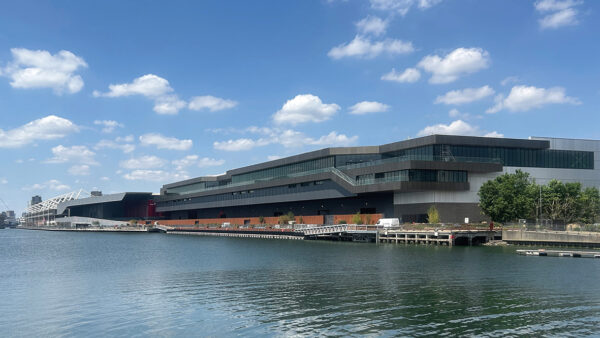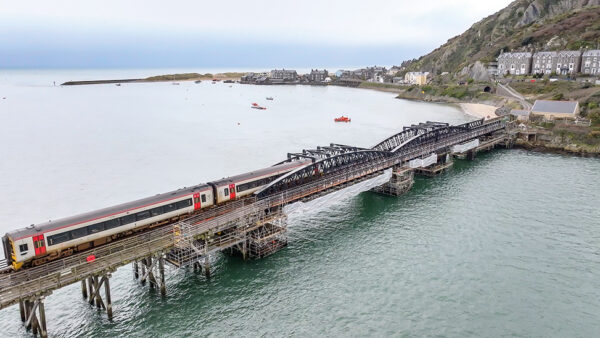
Computational Fluid Dynamics modelling used in motorsport could transform designs of buildings and cities, writes Mott MacDonald’s Ruth Shilston.
If you were asked what Formula 1 racing cars and buildings have in common, you might not initially think that the answer lies in their design – but it does.
Formula 1 teams have been using Computational Fluid Dynamics (CFD) modelling for a number of years to optimise their car designs at pace. Now the same technology has the potential to revolutionise the design of our buildings and cities too.
By understanding what CFD is, the benefits of applying this powerful tool to any engineering problem becomes clear. Essentially CFD is a branch of fluid mechanics that uses numerical analysis and algorithms to solve and analyse problems involving fluid flows. By simulating the behaviour of fluids – liquids and gases – and their interactions with surfaces, CFD modelling provides detailed insights into complex fluid dynamics phenomena. High-speed supercomputers enable complex and accurate simulations, allowing engineers to quickly tackle sophisticated problems.
As well as use by Formula 1 teams, such as Red Bull, to optimise the aerodynamics of car chassis, CFD is also an established engineering tool for the aerospace, automotive and energy industries.
CFD benefits for building design
The benefit for all these sectors, as well as buildings, comes from CFD’s simulations that allow for rapid design iterations. CFD modelling provides a virtual testing ground for various design scenarios, allowing engineers to optimise building designs before construction begins. This iterative process helps identify potential issues and refine designs to achieve optimal performance. By reducing the need for physical prototypes and experiments, CFD modelling saves time and resources, leading to more efficient project timelines.
A good example of how this can be applied to the design of buildings and cities is the use of CFD in the analysis of ventilation and airflow. Proper ventilation is crucial for maintaining indoor air quality, thermal comfort and energy efficiency. CFD modelling allows engineers to simulate and optimise airflow patterns, ensuring that fresh air is distributed evenly throughout the building while minimising energy consumption. This is particularly important in large commercial buildings, hospitals and schools.
Similarly, CFD modelling plays a vital role in simulating fire scenarios and predicting the behaviour of smoke and heat for more complex buildings where standard code-based approaches don’t easily apply. By analysing the spread of smoke and the effectiveness of smoke control systems, engineers can design safer buildings with improved evacuation plans and fire suppression systems.
The outputs from simulations are highly visual, allowing designers to look at complex fluid flows and understand key flow features. Use of CFD to analyse pollution dispersion, such as exhaust gases and particulate matter, around buildings and urban areas demonstrates the visual benefits. By understanding how pollutants spread and interact with the built environment, engineers can design buildings and urban layouts that minimise pollution exposure and improve air quality. The flow visualisations are a key communication tool to help non-technical clients and design team members to understand flow features.
Advanced computational modelling is also fundamental to our ability to design bigger, wider, longer and more complex architectural forms.
Analytical and code-based approaches include a degree of conservatism and often cannot be applied once a building exceeds a certain size or complexity. However, CFD overcomes this challenge and has been effective in analysis of the impact of tall buildings on wind speeds at ground level, which can create uncomfortable and, in extreme cases, unsafe conditions for pedestrians. For this reason, wind microclimate assessments are required to support planning applications for tall buildings and CFD is being used more and more frequently to do this. The results allow engineers and architects to shape buildings to eliminate strong wind issues.
Beyond these use cases, CFD has huge potential to deliver cost savings by identifying potential issues in the design phases, avoiding costly modifications and rework during construction.
CFD modelling considerations
While CFD modelling offers numerous benefits, it is not without its limitations. Setting up and running CFD simulations can be complex and requires specialised knowledge in fluid dynamics and numerical methods. Specific knowledge and experience are required to create a high-quality computational mesh – one of the key steps in running a CFD simulation – with appropriate resolution and refinement in critical areas. Coarse meshes can lead to inaccurate results, but overly fine meshes can increase computational costs unnecessarily.
CFD simulations are computationally intensive and require significant processing power so that cost must be factored in, alongside the need to validate the accuracy of simulations against experimental or physical data, which can also be costly and time-consuming.
While there are clearly factors to consider when determining whether CFD is the right technology for analysing your work, it stands out as a powerful tool that enhances design, analysis and optimisation processes. Use of CFD in Formula 1 is now business as usual and – in time – it is likely to become the same for design of buildings and cities too.
Ruth Shilston is technical director for engineering sciences at Mott MacDonald.











